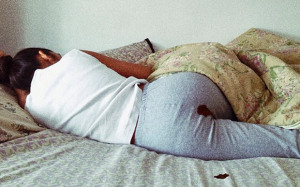This post was first published under the title The Year the Period Went Public on November 12, 2015 on Gender & Society, a publication of Sociologists for Women in Society. It is crossposted here with permission.
By Chris Bobel
In this month’s issue, Cosmopolitan dubbed 2015 “the year the period went public” [It is also the year I, for the first time ever, agreed with Cosmo.]
2015 has brought us a tremendous diversity of menstrual-positive expressions—from the artistic to the practical, the serious and the playful, local and the global.
2015 is the year that Instagram blew up when Rupi Kaur’s photo of her period –stained PJ pants was “accidentally” [twice] removed, and free-bleeding Kiran Gandhi ran the London Marathon. It is the year that efforts to de-tax menstrual products succeeded in Canada and gained momentum in Australia, Britain, and the United States while efforts to “de-tox” the same products, through the Robin Danielson Bill re-introduced in Congress this May, gets unprecedented press attention .
2015 brought us Barbie-alternative Yammily’s “Period Party”– a kit with an educational pamphlet, a doll-sized menstrual care kit including a pair of panties and 15 reusable pads.
In 2015, the unique menstrual challenges of women and girls living on the streets inspired a raft of grassroots campaigns, and a global movement to improve menstrual health for women and girls worldwide is thriving. For example, on May 28, 2015, the 3rd global Menstrual Hygiene Day was recognized through 127 events in 33 countries.
Periods are Not an Insult
Finally, in 2015 nearly everyone rolled their eyes when Donald impugned GOP debate moderator Megyn Kelly, saying she had “blood coming out of her wherever“–the most recent in the misogynist tradition of using menstruation to rationalize the perception of gendered incompetence. But, this time, we reacted differently. In 2015, Twitter slapped back with #periodsarenotaninsult.
Considered together, these events constitute a shift. Menstruation IS having its moment. I know, because I’ve had my ear to the ground for more than a decade and most of what I’ve heard is PMS jokes, goofy menstrually-theme bits in sitcoms and films, and of course, ubiquitous product ads [cue white woman in white pants on white horse].
I am not sure what’s in the soil that is sprouting this new awareness. No doubt, it is the same soil that is nurturing women’s expressions of frustration with stigma, as evinced by the new #shoutyourabortion campaign and the media frenzy swirling around Katha Pollit’s new book Pro.
Maybe the shift is an outgrowth of our breathlessly social-mediated realities, where what’s happening—literally—in one’s own pants can be shared with a few swipes or clicks. Or might the transformation in discourse be the next best example of a micro-level lifestyle movement that galvanizes the personal into a neo-political? I am not sure, but as we ponder this, a bigger question surfaces:
Is the Movement We’ve Been Waiting For?
For bodies with privilege (cisgendered, white, non-disabled, thin and so on), challenging menstrual invisibility and menstrual shame IS perhaps the last frontier. After all, the menstrual body IS abject; it is reviled because it challenges norms of the hyper-disciplined feminine body. The way menstruation and womanhood is socially constructed is perhaps the most vexing of patriarchy’s pernicious contradictions.
But we can’t lose sight of how the politics or respectability is intricately wound up in who can and cannot afford to smash any embodied taboo, least of all the menstrual mandate of silence and secrecy. Thus, the entire black body, trans body, disabled body, and fat body, for example, are read as abject–as deficit and thus, at risk. A blog post at “Crazy Cranky Sexy Cool” said it best: “So you can put period blood war paint on your face, and yes, in your context, it will probably be subversive and revolutionary. For the rest of us just going outside, walking in the streets, exposing our vulnerable, repulsive bodies is subversive and radical.”
We Can Do Better
So while we are celebrating a new era of menstrual awareness, we need to be mindful of who is authorized to dance at the new party. As we tweet our periods at Donald Trump, we must, at the same time, consider the lived realities of those of us who occupy a social space that vibrates—all day, every day—with peril. We have to remember that some bodies, to invoke Audre Lorde ‘were never meant to survive.’
If menstrual activists can practice some good ole self-reflexivity, noting how our particularly cozy social locations enable us to take these risks, we can build a bridge. If not, we merely prescribe a one-size-fits-all kind of new menstrual consciousness that keeps the movement small and fringy.
We can do better if we seize the chance to see the power of dominant culture to treat some bodies very differently (and very dangerously) than others. If we do, we can make this menstrual moment a powerful opportunity for authentically reckoning with our differences and shape a discourse that makes room for all bodies—bloody and otherwise–far beyond 2015.
Chris Bobel, president of the Society for Menstrual Cycle Research, is Associate Professor of Women’s and Gender Studies at the University of Massachusetts, Boston. Her areas of expertise include the politics of embodiment, health and social change, and the intersection of feminist theory and action. She is the author of New Blood: Third Wave Feminism and the Politics of Menstruation (Rutgers University Press, 2010).


